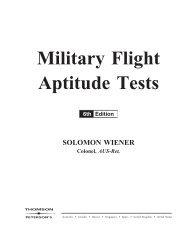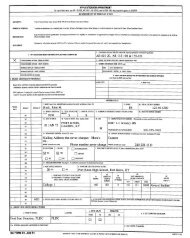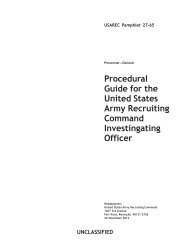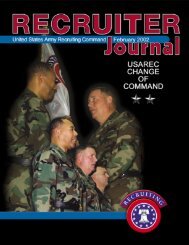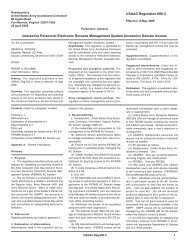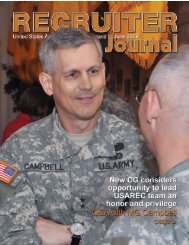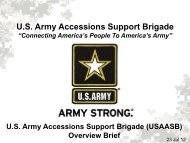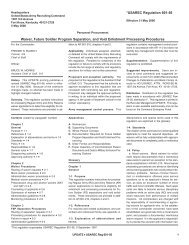Create successful ePaper yourself
Turn your PDF publications into a flip-book with our unique Google optimized e-Paper software.
l of the WAAC<br />
By Robyn Dexter, U.S. <strong>Army</strong> Women’s Museum<br />
As the war escalated in 1941, House Bill 6293 was put on<br />
the table. It called for women to enter and serve within<br />
the ranks of the <strong>Army</strong> to fill the roles men were leaving<br />
behind. After going through several revisions and fraught with<br />
challenges, the measure passed on May14, 1942, and the<br />
WAAC, Women’s <strong>Army</strong> Auxiliary Corps was born.<br />
Part of the WAAC’s mission was to recruit other women into<br />
the Corps and in the early days, that was an exercise of<br />
frustration. The policies changed frequently, public support<br />
was low, and the recruiters themselves were ill-prepared to take<br />
on the unique task of selling the <strong>Army</strong> to women.<br />
By early 1943, the pressure to enlist larger numbers of<br />
women had increased, and the standards were loosened.<br />
Women who would have previously been mentally, physically<br />
or legally disqualified were allowed to enlist. Public and military<br />
opinion declined as a result.<br />
In 1943, a poll of male Soldiers was conducted to determine<br />
if they would support their young sisters going into the<br />
WAAC. Forty percent firmly responded “No,” 25 percent<br />
answered yes, and a full 35 percent were undecided. More than<br />
one Soldier sent letters home threatening divorce or disinheritance<br />
if women joined the WAAC. The most frustrating<br />
problem facing recruiters was that they had no idea how to<br />
accomplish their task. No one had ever had to sell the <strong>Army</strong>,<br />
much less to women, a new and unchartered demographic.<br />
In 1943, the WAAC gave way to the WAC, giving women<br />
military status, the GI Bill and other veteran’s rights. These<br />
benefits led to increased reruiting numbers. In 1948, the<br />
Women’s Service Integration Act passed, establishing the<br />
WAC as a permanent part of the <strong>Army</strong>.<br />
Once its permanent place in the <strong>Army</strong> was established, the<br />
WAC looked for new and innovative ways to ensure a steady<br />
supply of both enlisted personnel and officers. American<br />
women were being given choices about their future like never<br />
before, and the WAC wanted to ensure that they knew the<br />
<strong>Army</strong> was one of them. In the early 1950s, there were three<br />
ways women could be commissioned in the Regular <strong>Army</strong>; the<br />
direct commission program, as a graduate of Officer Candidate<br />
School, and the Competitive Tour program. This program<br />
allowed reserve officers to do a one year active-duty tour in<br />
multiple specializations where her strengths would be analyzed.<br />
Those with the highest ratings were offered appointments.<br />
Commanders also could nominate outstanding enlisted women<br />
to attend OCS.<br />
Another of the most successful programs was the 13-week<br />
Associate WAC Company Officers Course. Applicants could<br />
apply based on their college education and work and life<br />
experiences for commission. For example, a woman applying to<br />
be a captain had to have at least a bachelor’s degree with at<br />
least five years of demonstrated professional leadership.<br />
Traditional recruiting sources such as the military academies<br />
and ROTC were not available, so recruiters had to be resourceful.<br />
In 1954, the College Junior program began. For three weeks,<br />
candidates would come to Fort McClellan, Ala., for the experience<br />
of being a WAC. After completion, they were placed on<br />
inactive duty, earned a commission upon graduation, and<br />
reported to the WAC Officer Basic Course the summer after<br />
graduation. This program lasted until 1966.<br />
There were a variety of enlistment options. The two-year<br />
enlistment options were the CONUS Station of Choice, Service<br />
School enlistment and Warrant Officer Flight Training. The<br />
WAC band was a large recruiting tool, as it provided visibility.<br />
Another very successful program was a traveling event called<br />
“Serving With Pride and Dignity,” which presented the history<br />
of women in the military, in a pageantry format to women’s<br />
clubs, schools and social events all around the country. It<br />
toured for six and a half years.<br />
With the escalation of the Vietnam War came an aggressive<br />
recruiting campaign. Orders were to increase the numbers of<br />
enlisted women from 4,000 to 6,000 a year and officers from 180<br />
to 300.<br />
One of <strong>Army</strong>’s biggest issues at this point was retention.<br />
Marriage and children were a major obstruction. Regulations<br />
regarding discharge upon <strong>mar</strong>riage changed several times, and<br />
pregnancy was an automatic discharge.<br />
Though recruiters were meeting quotas, rather than increasing<br />
strength, they were just filling voids left by women getting<br />
out of the <strong>Army</strong>. In 1968 <strong>mar</strong>riage accounted for a 4.2 percent<br />
discharge. By 1975, it was 10 percent. Pregnancy discharge<br />
rates, however, declined from 25 percent in 1968 to 16.9 percent<br />
in 1975. When combined with the declining popularity of the<br />
Vietnam War, fewer women were volunteering.<br />
But with the rise of the feminist movement, the proposed<br />
Equal Rights Amendment, and new <strong>Army</strong> career fields opened<br />
to women, the WAC saw a boost in recruiting to levels it had<br />
never before experienced. Women were looking for career<br />
opportunities and first term enlistments began rising in 1973.<br />
Recruiters saw a dramatic increase when new regulations made<br />
all but 48 of the 485 MOS options available to women.<br />
By 1973, legislation was being drafted to discontinue the<br />
WAC. By October 1978, the WAC was a part of <strong>Army</strong> history.<br />
RECRUITER JOURNAL | MARCH 20<strong>09</strong> | 15



